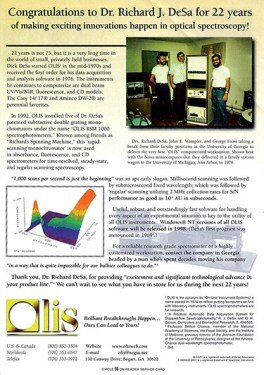Some Known Factual Statements About Circular Dichroism

Branch of spectroscopy Table-top spectrophotometer Beckman IR-1 Spectrophotometer, ca. 1941 Beckman Design DB Spectrophotometer (a double beam model), 1960 Hand-held spectrophotometer utilized in graphic market Spectrophotometry is a branch of electro-magnetic spectroscopy worried with the quantitative measurement of the reflection or transmission residential or commercial properties of a product as a function of wavelength.
Spectrophotometry is a tool that hinges on the quantitative analysis of molecules depending on how much light is absorbed by colored substances.
Some Known Questions About Uv/vis/nir.
A spectrophotometer is commonly used for the measurement of transmittance or reflectance of services, transparent or opaque solids, such as refined glass, or gases. Although numerous biochemicals are colored, as in, they soak up noticeable light and therefore can be measured by colorimetric procedures, even colorless biochemicals can often be transformed to colored compounds appropriate for chromogenic color-forming responses to yield substances ideal for colorimetric analysis.: 65 Nevertheless, they can likewise be created to determine the diffusivity on any of the listed light varieties that usually cover around 2002500 nm using different controls and calibrations.
An example of an experiment in which spectrophotometry is used is the decision of the stability constant of a solution. A specific chain reaction within a service might take place in a forward and reverse direction, where reactants form products and products break down into reactants. At some point, this chain reaction will reach a point of balance called an equilibrium point.
Uv/vis Can Be Fun For Anyone
The amount of light that goes through the option is a sign of the concentration of specific chemicals that do not enable light to go through. The absorption of light is due to the interaction of light with the electronic and vibrational modes of particles. Each kind of molecule has a private set of energy levels associated with the makeup of its chemical bonds and nuclei and thus will absorb light of particular wavelengths, or energies, resulting in unique spectral properties.
They are commonly utilized in numerous markets including semiconductors, laser and optical production, printing and forensic assessment, as well as in laboratories for the study of chemical compounds. Spectrophotometry is often used in measurements of enzyme activities, determinations of protein concentrations, decisions of enzymatic kinetic constants, and measurements of ligand binding reactions.: 65 Ultimately, a spectrophotometer is able to figure out, depending on the control or calibration, what substances are present in a target and exactly how much through estimations of observed wavelengths.
This would come as a service to the formerly created spectrophotometers which were not able to take in the ultraviolet properly.
A Biased View of Spectrophotometers
It would be found that this did not offer satisfactory outcomes, for that reason in Design B, there was a shift from a glass to a quartz prism which enabled for much better absorbance outcomes - circular dichroism (https://sketchfab.com/olisclarity1). From there, Model C was born with an adjustment to the wavelength resolution which ended up having three systems of it produced
It was produced from 1941 to 1976 where the rate for it in 1941 was US$723 (far-UV devices were a choice at additional cost). In the words of Nobel chemistry laureate Bruce Merrifield, it was "probably the most essential instrument ever developed towards the development of bioscience." Once it ended up being stopped in 1976, Hewlett-Packard developed the very first commercially offered diode-array spectrophotometer in 1979 called the HP 8450A. It irradiates the sample with polychromatic light which the sample takes in depending upon its residential or commercial properties. Then it is transferred back by grating the photodiode variety which detects the wavelength region of the spectrum. Because then, the production and execution of spectrophotometry devices has actually increased exceptionally and has actually ended up being one of the most ingenious instruments of our time.

Some Known Details About Uv/vis
Historically, spectrophotometers use go right here a monochromator containing a diffraction grating to produce the analytical spectrum. The grating can either be movable or fixed. If a single detector, such as a photomultiplier tube or photodiode is used, the grating can be scanned stepwise (scanning spectrophotometer) so that the detector can measure the light strength at each wavelength (which will represent each "action").
In such systems, the grating is repaired and the strength of each wavelength of light is determined by a different detector in the range. When making transmission measurements, the spectrophotometer quantitatively compares the portion of light that passes through a referral service and a test service, then digitally compares the intensities of the two signals and computes the percentage of transmission of the sample compared to the recommendation requirement.
Comments on “The Ultimate Guide To Circularly Polarized Luminescence”